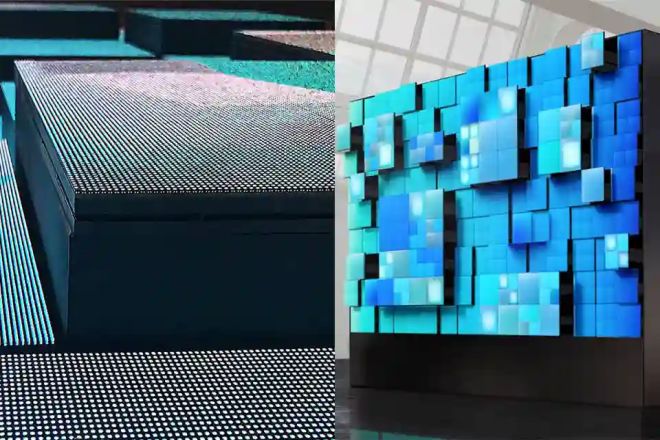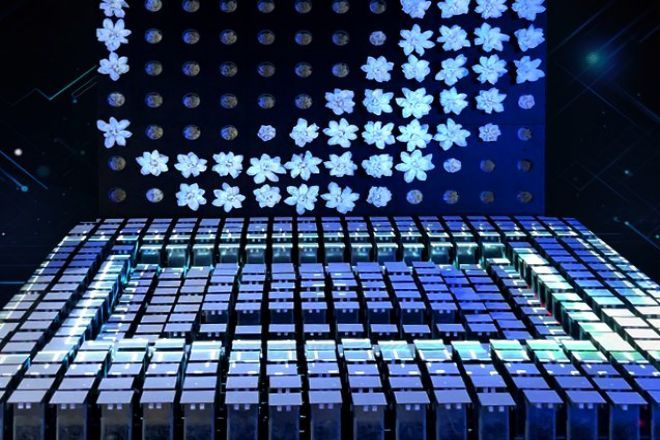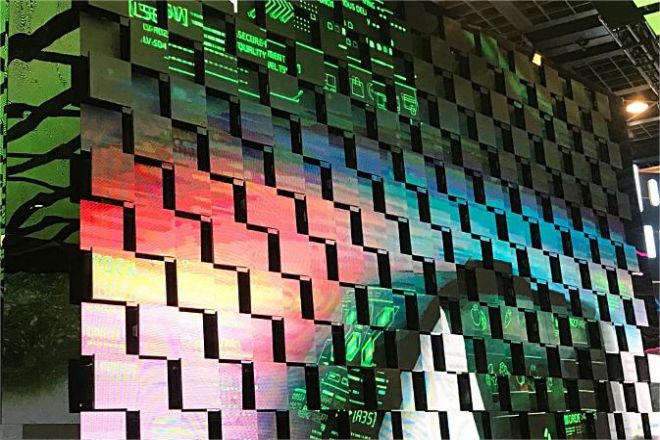Introduction
With the increasing advancement of science and technology, the field of Écrans d'affichage LED is ushering in technological innovation. As an innovative product that combines 3D display technology and mechanical kinetic energy technology, 3D kinetic energy LED display not only provides a rich visual experience but also brings a more immersive interactive experience to the audience through mechanized dynamic effects.
1. Overview of 3D kinetic energy LED display

The 3D kinetic energy LED display is an LED display that combines mechanical kinetic energy technology and 3D display technology. It not only provides high-quality image and video display but also brings an immersive visual experience to the audience through mechanized dynamic effects.
This kind of display screen is usually equipped with mechanical kinetic energy systems, such as servo motors and transmission devices so that the display content can be presented in a dynamic and movable manner.
Compared with traditional LED displays, 3D kinetic energy LED displays have the following significant differences and advantages:
3D display effect: Traditional LED displays can only present flat images and videos, while 3D kinetic LED displays can display three-dimensional images, making the audience feel as if they are actually there.
Effet dynamique : Driven by the mechanical kinetic energy system, the 3D kinetic energy LED display can achieve dynamic and movable display content, such as dynamic changes in text, images, and videos, which increases the fun and attractiveness of the displayed content.
Expérience interactive : Combined with sensors and control systems, 3D kinetic energy LED displays can interact with the audience, such as controlling changes in display content through gestures, touch, etc., bringing a richer interactive experience to the audience.
2. Working principle of 3D kinetic energy LED display
Imagine that an ordinary LED display is like a static picture frame, which can only display a flat picture. However, the 3D kinetic energy LED display is different. It is like a moving stage. The pictures on it can not only be displayed but also move!
So, how does it do it? The answer is the introduction of mechanical dynamic systems with mobility. This system is like the “hands and feet” of the display screen, allowing it to “move.”
How are these “hands and feet” composed? There are three key parts:
Servo motor: It is like a powerful “motor” that can provide precise power output to make the content on the display move in the way we want.
Transmission device: It is like the “arm” that connects the “motor” and the display screen and is responsible for transmitting the power of the servo motor to the LED module on the display screen.
Motion control module: It is like the “brain” of the display screen. It can receive our preset instructions or external signals and then tell the servo motor how to move, such as rotation, translation, or lifting.
Therefore, when we play a video, the 3D kinetic energy LED display can make the picture move through the mechanical dynamic system according to the content of the video, bringing a more realistic and vivid 3D experience to the audience.
3. Analysis of key technologies of 3D kinetic energy LED display

1). Technologie d'affichage LED
LED display technology is the basis of 3D kinetic energy LED display. Its key technologies include:
- Application of high-brightness and high-definition LED chips:
The use of high brightness and high-definition LED chips can ensure that the display screen still maintains a clear display effect in outdoor or strong light environments. At the same time, high-definition LED chips can present more delicate images and enhance the audience’s viewing experience.
- Optimized design of LED pixel array:
Through reasonable layout and optimized design of LED pixel array, higher pixel density, and better display effect can be achieved. At the same time, optimized design can also improve the reliability and stability of the display and reduce the failure rate.
- Color management and calibration technology:
Color management and calibration technology are the keys to ensuring accurate and vivid colors of LED displays. Through professional color calibration instruments and software, the color temperature, brightness, saturation, and other parameters of the display can be accurately adjusted to achieve the best color effect.
2). 3D display technology
3D display technology is the core of 3D kinetic energy LED display. Its key technologies include:
- 3D content production and conversion technology:
In order to present realistic 3D effects on a 3D kinetic LED display, specialized 3D content production and conversion technology is required. These technologies can convert 2D content into 3D content or produce specialized 3D content to adapt to the 3D display effect.
- Enhancement and adjustment of stereoscopic visual effects:
By adjusting the brightness, contrast, viewing angle, and other parameters of the display screen, the stereoscopic visual effects can be further enhanced. At the same time, technical means such as multi-viewpoints and multi-levels can also be used to enable viewers to see clear 3D effects at different locations.
- Dynamic adaptation technology of the viewer’s perspective:
Since viewers may be in different positions and angles when viewing the display, dynamic adaptation technology of the viewer’s perspective is needed. This technology can automatically adjust the display content and angle of the display according to changes in the viewer’s perspective, ensuring that the viewer can always see the best 3D effect.
3). Mechanical kinetic energy technology
Mechanical kinetic energy technology is the key to achieving dynamic effects in 3D kinetic energy LED displays. Its key technologies include:
- Design of high-precision motion control system:
The high-precision motion control system is the basis for ensuring the precise movement of the LED module on the display screen. The system requires a high degree of accuracy and stability to ensure that the display’s motion effects meet preset requirements.
- Matching and optimization of servo motors and transmission devices:
Servo motors and transmission devices are the core components of the mechanical kinetic energy system. In order to ensure the best movement effect of the display screen, the servo motor and transmission device need to be accurately matched and optimized. This includes selecting the appropriate motor model, optimizing the structure and parameters of the transmission, etc.
- Synchronous control technology for dynamic effects and LED display:
In order to ensure the coordination between the mechanical kinetic energy system and the LED display system, it is necessary to adopt synchronous control technology for dynamic effects and LED displays. This technology ensures that the LED modules on the display remain synchronized with the played video content when moving, thereby presenting a more realistic and smooth 3D effect.
4. Application fields of 3D kinetic energy LED display
1). Advertising and commercial display
- Brand promotion and product promotion:
The high brightness and high definition of the 3D kinetic energy LED display make it an excellent choice for brand promotion and product promotion. Through dynamic and three-dimensional display methods, you can attract more consumers’ attention and increase brand awareness and product sales.
- Eye-catching interactive experience:
Its movable design can add more fun and interactivity to advertisements, attract consumers to stop and watch and participate in interactions, and improve the conversion effect of advertisements.
- Real-time updated advertising content:
Due to its digital characteristics, the 3D kinetic energy LED display can quickly update advertising content, maintain the freshness and relevance of information, and meet advertisers’ needs for real-time tracking and adjustment of advertising effects.
2). Entertainment and Stage Performance
- Live performances such as concerts:
In live performances such as concerts and concerts, the 3D kinetic LED display can be used as a large background screen to present more shocking and realistic visual effects to the audience. By playing dynamic pictures that match the performance content, you can create a stronger atmosphere and enhance the audience’s viewing experience.
- Combination of virtual reality and augmented reality applications:
3D kinetic LED displays can be combined with virtual reality and augmented reality technologies to provide viewers with a more immersive viewing experience. For example, in a concert, the audience can wear VR glasses and use the 3D kinetic energy LED display to interact closely with the performers as if they are at the scene.
- The interactive experience between the audience and the performers:
Its interactive and movable design can shorten the distance between the audience and the performers, allowing the audience to participate more deeply in the performance. For example, at a concert, the audience can interact with the performers in real time by sending comments or participating in voting through mobile phones or other devices.
3). Exhibitions and museum displays
- Three-dimensional display of historical relics and artworks:
In exhibitions and museums, 3D kinetic LED displays can be used to display three-dimensional images of historical relics and artworks. Through high-precision image capture and rendering technology, the three-dimensional effect of cultural relics and artworks can be presented, allowing viewers to more intuitively understand details such as their shape, structure, and texture.
- Combination of interactive experience and educational functions:
In addition to display functions, 3D kinetic energy LED displays can also be combined with interactive experiences and educational functions. For example, in a museum, visitors can interact with exhibits and obtain relevant knowledge and information by touching the screen or wearing VR glasses. This interactive experience not only increases audience engagement and interest but also enhances learning.
- Integration of multimedia display and navigation systems:
3D kinetic LED displays can be integrated with multimedia display and navigation systems to provide audiences with a more comprehensive and convenient visiting experience.
By displaying multimedia content such as videos, audio, and pictures related to the exhibits and providing intelligent navigation services, the audience can better understand the historical background and cultural connotations of the exhibits and gain a deeper understanding of the exhibition’s theme and content.
5. Challenges and future development of 3D kinetic energy LED displays

1). Défis techniques
- The balance between display effect and energy consumption:
While pursuing high brightness, high definition, and dynamic effects, 3D kinetic energy LED displays also face the problem of increased energy consumption. How to reduce energy consumption while ensuring display effects is an important issue that needs to be solved in technology research and development.
- Stability and reliability of mechanical systems:
As the core component of the 3D kinetic energy LED display, the mechanical dynamic system’s stability and reliability directly affect the service life and effect of the display. How to ensure that mechanical systems can operate stably in various environments is another major challenge in technology research and development.
- High costs and maintenance issues:
At present, the cost of 3D kinetic energy LED displays is relatively high, which limits its popularity and application in the market. At the same time, due to its complex structure and technology, maintenance is also difficult. In the future, reducing costs and simplifying maintenance processes will be important directions for technology research and development.
2). Market challenges
- Consumer acceptance and market cultivation:
For the emerging 3D kinetic energy LED display, consumer awareness and acceptance still need to be improved. The market needs to be promoted and popularized through various channels to increase consumer awareness and interest in products.
- Competitive landscape and brand building:
As the market continues to develop, competition in the field of 3D kinetic energy LED displays will become increasingly fierce. Enterprises need to strengthen brand building and improve product quality and service levels to stand out from the competition.
2). Future trends
- Flexible and bendable 3D kinetic energy LED display:
With the continuous development of flexible display technology, 3D kinetic energy LED displays are expected to achieve flexible and bendable designs in the future. This will bring greater flexibility and adaptability to the product to meet the needs of use in different scenarios.
- The development of intelligence and networking:
With the continuous development of technologies such as the Internet of Things, big data, and artificial intelligence, 3D kinetic energy LED displays will achieve more intelligent and networked functions in the future. Through connection and interaction with other smart devices, more convenient and intelligent display and control methods are achieved.
- Integration of multi-sensory interactive experiences:
In addition to visual experience, future 3D kinetic energy LED displays will also integrate multi-sensory interactive experiences. For example, combining sound, touch, and other sensory elements can bring a more comprehensive and immersive interactive experience to the audience.
- Customized and personalized solutions:
With the continuous segmentation of market demand and the strengthening of the trend of personalization, 3D kinetic energy LED displays will pay more attention to customized and personalized solutions in the future. Enterprises need to provide customized products and services based on the needs and scenarios of different customers to meet the diverse needs of the market.
Conclusion
3D kinetic energy LED display has brought revolutionary changes to the fields of advertising, entertainment, exhibitions, and other fields with its unique mechanical kinetic energy and 3D display effect.
Although it still faces some technical challenges and market challenges, with the continuous advancement of technology and the gradual maturity of the market, 3D kinetic energy LED displays are expected to show broader application prospects in the future.
Enfin, si vous souhaitez en savoir plus sur les écrans LED, veuillez nous contacter.
